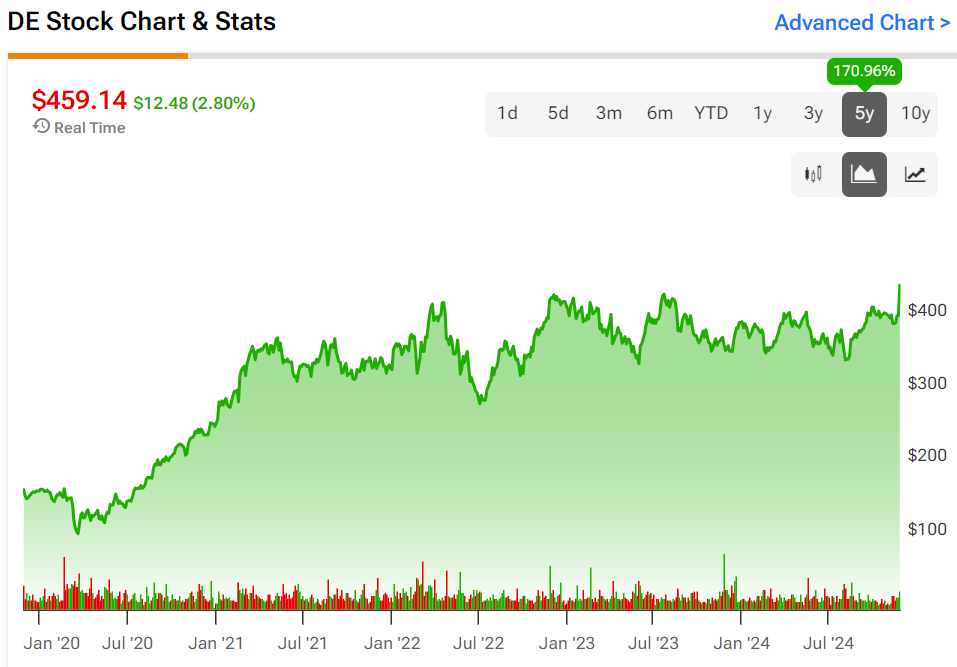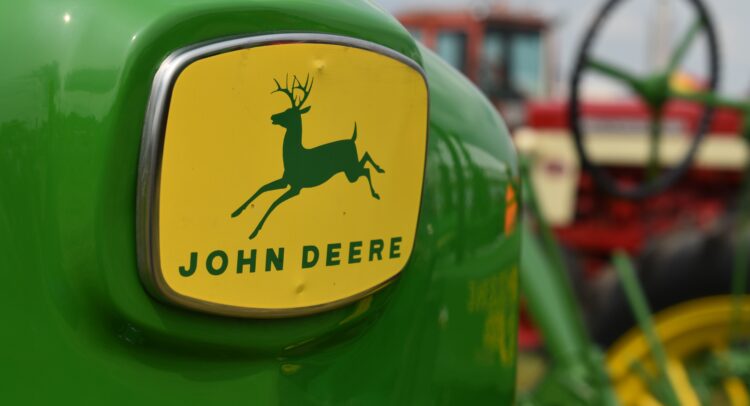Buying companies that are behind iconic brands and holding them for the long haul tends to be an investment strategy that works out well. Brands that are well known and trusted often generate respectable revenue and earnings growth throughout a full business cycle, leading to stable dividends and capital appreciation over time. Deere & Company (DE), a prime example of this approach, has become a favorite among dividend growth investors. The agricultural machinery and heavy equipment company has seen its shares rally an impressive 171% over the last five years, prompting the question: Is Deere a buy for dividend growth investors today?
After releasing its Fiscal Q4 2024 earnings report last week, I’m optimistic that Deere isn’t too far away from seeing a turnaround and the next upswing in its business. While the fundamental picture is encouraging, the valuation seems to already be pricing in this business recovery. That’s why I’m beginning coverage with a Hold rating.

Deere Outran Analyst Expectations in Q4
On November 21st, Deere’s Q4 2024 earnings report offered insight into my Hold rating. The company’s net sales fell by 27.7% year-over-year to $11.14 billion during the quarter. Higher financing and input costs and lower crop prices for its customers were the factors that led to a softening of demand for Deere’s products in the quarter and throughout Fiscal year 2024. Even so, the company did manage to beat analyst topline expectations for the quarter by $1.94 billion. Deere’s diluted EPS dropped by 44.9% over the year-ago period to $4.55 during the quarter. For perspective, that exceeded the analyst consensus by $0.68 in the quarter.
Catalysts Are Emerging for Deere
The case can be made that despite near-term headwinds, Deere has tailwinds on the horizon that could position it for a strong bounce back to support my Hold rating. To be clear, Deere expects crop prices to decline further in Fiscal Year 2025. On the flip side, this is expected to be somewhat countered by improving yields from lessening drought concerns, as highlighted by Investor Communications Manager Josh Rohleder during the Q4 2024 earnings call. These factors should help input costs improve in Fiscal Year 2025 and beyond.
Additionally, interest rates are likely to remain elevated throughout Deere’s Fiscal Year 2025. However, the consensus suggests that the federal funds rate will see cuts ranging from 50 to 100 basis points between now and next October, marking the end of Deere’s Fiscal year. This would follow three 25-basis-point cuts from the peak rate. Over time, these reductions should give Deere’s customers an opportunity to adjust. Since Deere’s products are expensive and often require financing, easing interest rates could help remove a significant obstacle to growth.
Taking these factors into account, analysts predict diluted EPS will fall another 24.4% in Fiscal Year 2025 to $19.36. However, the outlook improves in Fiscal Year 2026, with a projected 16% increase to $22.45. By Fiscal Year 2027, diluted EPS is expected to rise another 10.5% to $24.81, reflecting a recovery trajectory.
Deere Pays a Secure Dividend and Possesses a Robust Balance Sheet
Deere’s dividend is another reason that I like it enough to warrant a Hold rating. The DE stock’s 1.3% dividend yield matches the industrial sector average. The big appeal to Deere, though, is its dividend growth. The industrial has grown its dividend each year since 2009, with its five-year dividend growth rate registering at 93.4% cumulatively. In the years ahead, Deere should have room to keep growing its payout. That’s because even at what will likely be an earnings trough, the company’s dividend payout ratio is set to be in the low to mid-30% range for Fiscal Year 2025.
Beyond its dividend growth, Deere’s strong financial positioning further supports my Hold rating. The company’s interest coverage ratio was 6.3 in Fiscal Year 2024, a reassuring figure given the current industry downturn. For its part, Deere’s debt-to-capital ratio in the high-40% range further demonstrates its financial resilience. Reflecting this stability, S&P Global (SPGI) has awarded the company an A credit rating with a stable outlook.
DE Shares May Be Fully Priced
The one element of Deere that holds me back from issuing a Buy rating is its valuation. The forward P/E ratio of 20.4 is materially higher than the 10-year average P/E ratio of 16.1. It’s worth noting, as an industrial, that Deere’s Fiscal year 2026 diluted EPS could come in meaningfully above the current analyst consensus. I certainly see that as a likely scenario. Yet, even applying a 15% earnings beat, Deere’s forward P/E ratio would still be approximately 17.8. In my view, this significantly limits the stock’s upside for at least the next 12 to 24 months. That’s what is behind my Hold rating, despite my overall positive outlook toward the company’s operating fundamentals.
What Is Wall Street’s Take?
Shifting gears to Wall Street, analysts have a Moderate Buy rating consensus for Deere. Among 12 analysts, seven have assigned Buy ratings and the other five have issued Hold ratings in the past three months. The average 12-month DE price target of $453.00 implies a 1.34% downside from the current share price.

Investment Summary
Deere is arguably a high-quality dividend growth stock, supported by its robust balance sheet, secure and growing dividend, and history of financial resilience. As headwinds like high interest rates and declining crop prices begin to ease, and tailwinds such as improved yields and reduced drought concerns emerge, the company appears poised to regain momentum in the coming quarters. However, these positive expectations are already largely baked into the stock price, which limits the immediate upside potential. For these reasons, I maintain my Hold rating for Deere.
















